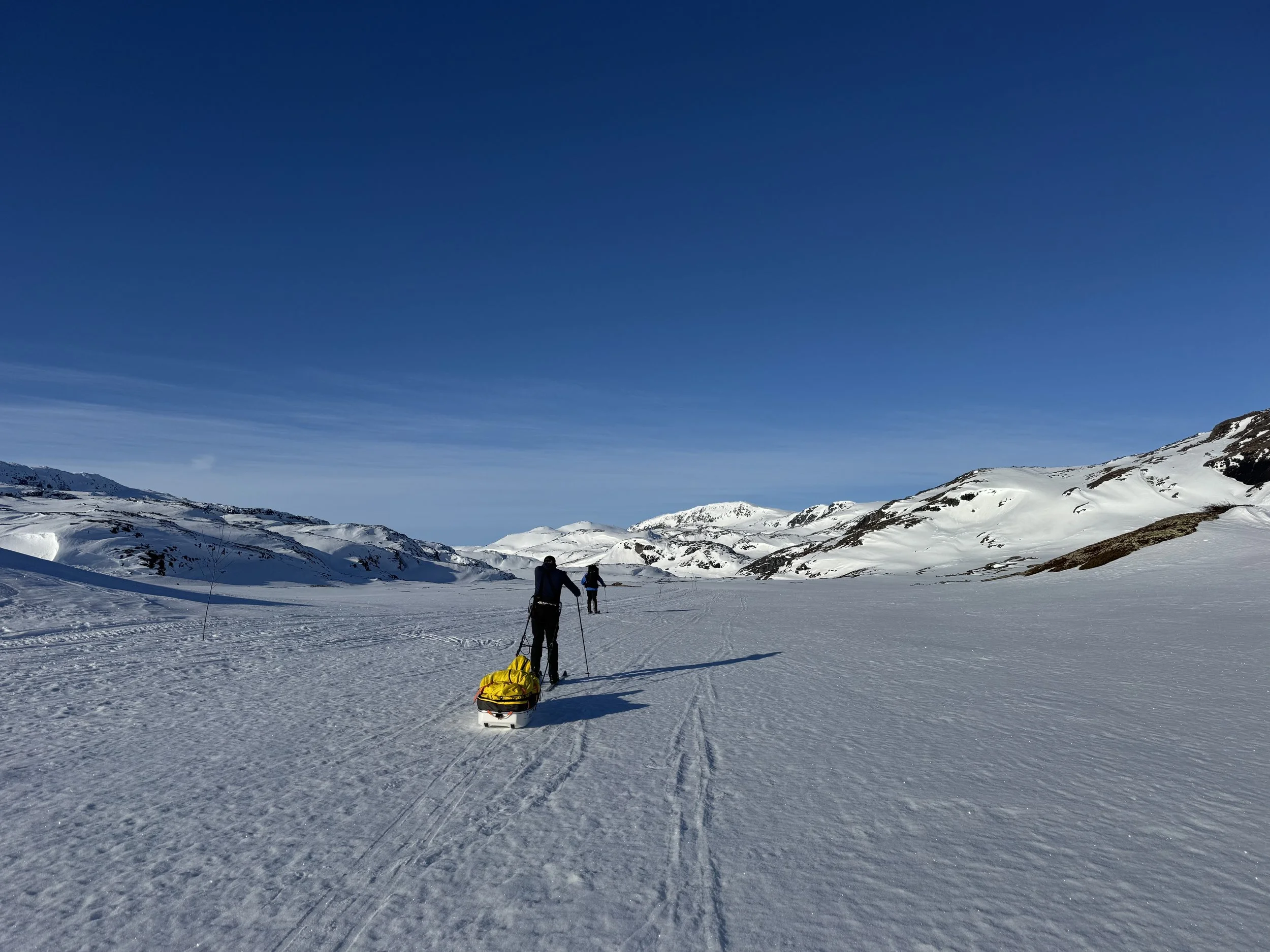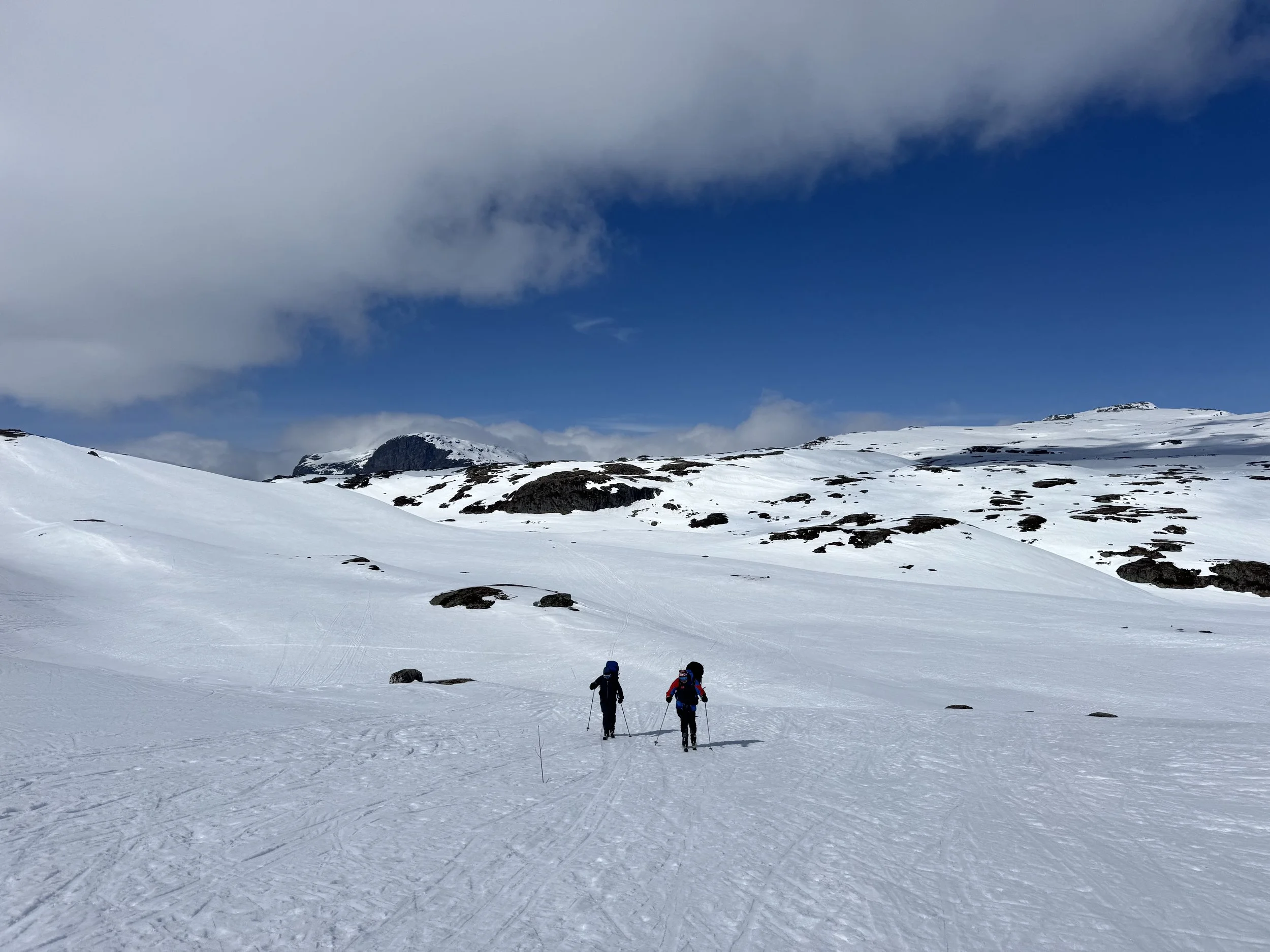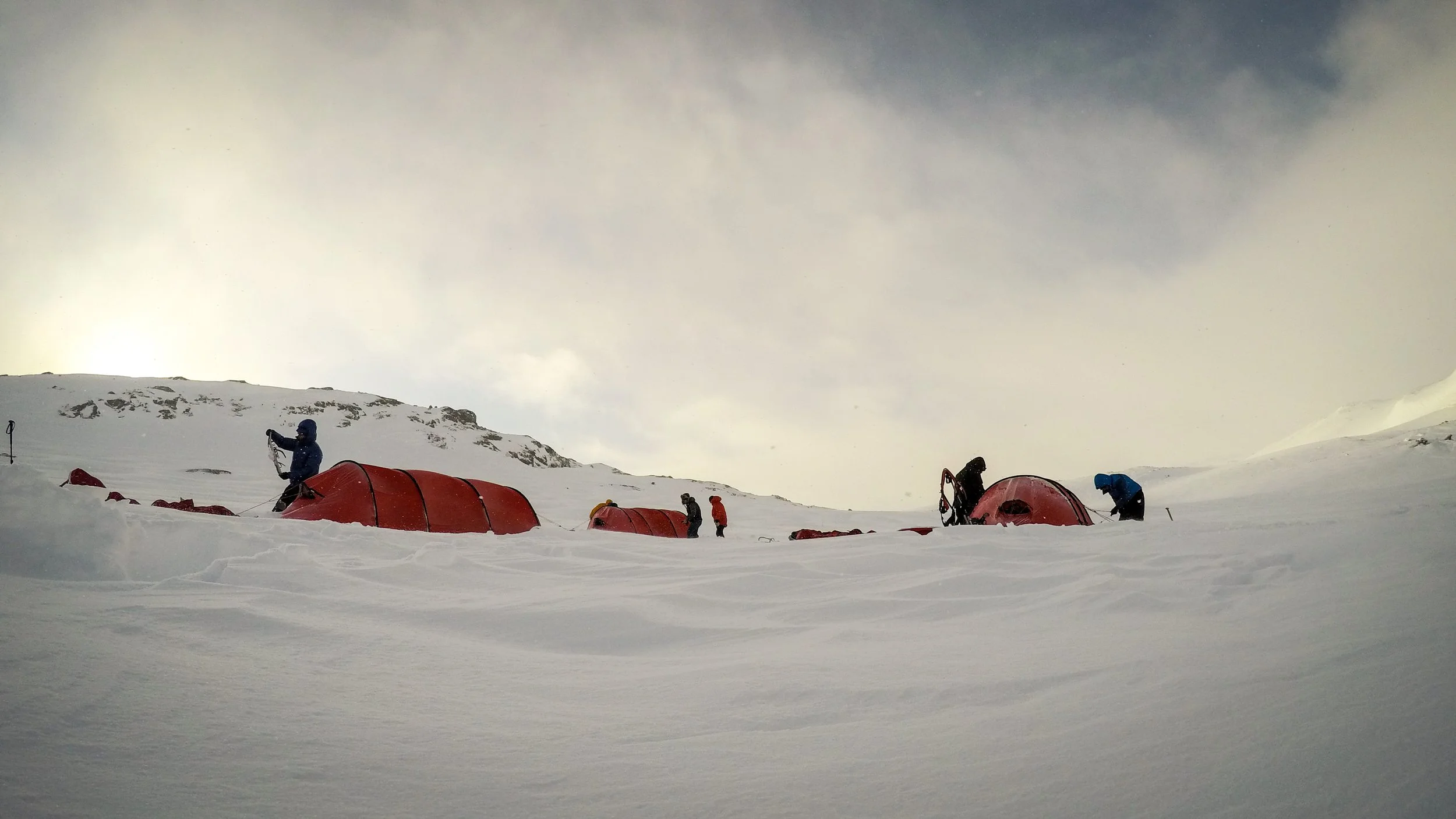Hardangervidda Crossing: Finse to Rjukan vs Finse to Haukeliseter – Which Route Suits You?
Why I Love Hardangervidda in Winter
I love the Hardanger plateau in the winter. The logistics are slick with minimal faff. You step off the train at Finse and, within a few metres, you’re pulling your pulk across the snow. It’s hard to beat that level of access. The terrain changes constantly – high plateau sections, steep punchy ascents, and long stretches across frozen lakes. The trails are marked earlier than in most areas. DNT marks them with willow wands every 10m, carefully avoiding avalanche terrain and other hazards, giving confidence for route planning in poor visibility.
We’ve got two confirmed expeditions running in Feb/March 2026 – two separate teams crossing two different routes. Personally, I always prefer to travel self-supported. Sure, the huts have their appeal: a cold beer, warm fire, decent food. But for me, that sense of comfort disconnects from the deeper experience of being fully immersed in the environment. The huts can be busy too – noisy, crowded, toilets full. What I really love is the nomadic rhythm of carrying everything in your pulk and adapting the journey to the group’s needs and the weather. It gives you more flexibility and fewer compromises.
If you're looking for a Hardangervidda winter expedition, comparing these two self-supported routes—Finse to Rjukan and Finse to Haukeliseter—will help you choose the right experience whether you plan to snowshoe or ski.
Having the right equipment and organisation is key on a Hardangervidda crossing!
Why Cross the Hardangervidda in Winter?
1. A Classic Polar Training Ground
Hardangervidda is where many serious polar expeditions begin their training. It offers exposure to genuine Arctic conditions without needing to commit to a longer Arctic expedition further afield. Cold, wind, and long distances on skis or snowshoes – it’s a tough but accessible environment for building the skills and mindset needed for trips like Svalbard, Greenland, or the North Patagonian Icefield.
2. Historical Significance
This is the same plateau where Amundsen trained before heading south, and where the Norwegian saboteurs famously crossed during the heavy water missions of WWII. There’s a deep sense of history under the snow.
3. Self-Sufficiency and Remoteness
Despite the good transport links, once you're on the plateau you’re in a place that can be fiercely wild. Weather moves fast. The sense of remoteness is real. Being self-supported adds a layer of challenge and freedom that brings a strong sense of purpose to every day.
What the Hardangervidda trails look like.
Route 1: Finse to Rjukan (Snowshoe-Friendly Hardangervidda Crossing)
This route is slightly more committing, though both options cross a road by day 2, offering the possibility to shorten the trip or adjust the route if needed. From a logistics point of view, it’s actually easier to make changes on this route and loop back to the main trainline without significantly increasing costs for clients.
It has fewer huts, and the descent into Rjukan is steep – but can be avoided via the ski lift or a longer route. It’s an excellent option for those training for future expeditions to Svalbard or Greenland. You’ll get a feel for self-supported movement, winter camp management, and working with pulks in a cold and demanding environment.
The Steep descent down into Rjukan on snowshoes!
Route 2: Finse to Haukeliseter (Classic Ski Tour Across Hardangervidda)
This route feels more like a classic ski tour and offers more rolling terrain. There’s a little more flexibility day to day, and it’s well suited to those newer to self-supported polar travel. The route gives a strong sense of traversing the full breadth of the plateau. It ends with a challenging final day, involving steep uphill sections and a more technical descent on cross-country skis.
Although both routes require transfers out of the valleys, the Haukeliseter route tends to feel longer logistically, especially at the end of a tough expedition.
The Final big climb of the expedition before descending into Haulkeliseter
How to Choose Between Routes
If you’re on snowshoes, I’d lean towards Rjukan. It allows more manageable route adjustments and a better descent into the valley. For cross-country skis, Haukeliseter offers more flowing terrain and an engaging challenge.
I personally feel the Haukeliseter route is tougher overall. Both start in Finse, but the logistics at the far end differ in feel. If you’re unsure which route fits best, just get in touch. I’m happy to offer advice, whether you’re joining one of our expeditions or planning your own. And if you need kit, our specialist rental store has everything you need without committing to buying it all.
What to Expect on Either Crossing
Daily Routine
We usually work on a simple rhythm: ski or snowshoe for 1 hour, rest for 10–15 minutes, repeat. After a few cycles, we take a longer break for lunch, then carry on. Tents are Hilleberg Keron 3GTs and we use a specific setup technique to protect against wind. In strong weather we build protective walls, double up poles in each sleeve, and pile snow around the base. Cold air wells are dug at tent entrances, and the stove gets fired up quickly to melt snow for drinking and cooking.
Wildlife
Hardangervidda is home to Europe’s largest wild reindeer herd – sometimes numbering over 10,000 across the plateau. Arctic foxes are also seen, along with ptarmigan, occasional wolverine tracks, and ravens riding the wind. It’s a quiet landscape but full of life.
Gear and Preparation
Dialling in your kit for this trip is absolutely essential. When you step off the train at Finse, you’re straight into a genuine Arctic environment – no warm-up. Knowing your packing systems matters. If using a pulk, I like to keep a hip or bum bag with essentials: snacks, wax, lip balm, sun cream, phone. Lunch, water, and flasks go in the front of the pulk for easy access, especially if using a bedding bag system.
The team is setting up camp
Ready to Join Us?
We currently have 3 places left on the ski expedition to Haukeliseter and 4 places on the snowshoe expedition to Rjukan (as of June 2025).
All our expeditions include a UK-based training weekend where we:
Go into the route in detail
Talk through equipment and packing systems
Practice tent setup and pulk use
Spend 1.5 days out on the hill learning how to manage your layers, work with liquid fuel stoves, and operate in cold conditions safely
You can find full details and book your place below:
👉 Join our Finse to Haukeliseter ski crossing – Feb 2026
👉 Join our Finse to Rjukan snowshoe expedition – March 2026
FAQs
Do I need ski experience?
For the ski expedition, yes – previous experience on Nordic or cross-country skis is important. We’re happy to advise on what counts as relevant experience. For snowshoeing, good fitness and winter hillwalking experience are fine.
Can I rent the gear?
Yes – we run our own rental service with pulks, tents, stoves, skis, snowshoes, and winter expedition kit.
How cold does it get?
Temperatures can drop to -20°C or lower. Good preparation and layering systems are vital, and we cover all of this during the UK training weekend.
How many people are on each trip?
We run small group expeditions with a maximum of 6 participants per guide. This keeps the team flexible and focused.
For more information on kit, route planning, and polar skills, check out our other blogs or visit the DNT site for up-to-date trail marking info.





